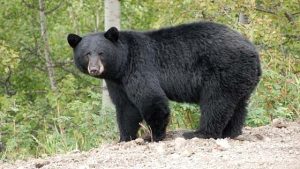 The Indiana Department of Natural Resources today confirmed the presence of a black bear in and around Corydon in southern Indiana.
The Indiana Department of Natural Resources today confirmed the presence of a black bear in and around Corydon in southern Indiana.
The bear was first reported around 9 p.m. Sunday. Indiana Conservation Officers received a call from a Harrison County homeowner of a bear going through the caller’s garbage.
Conservation officers, sheriff’s deputies and local animal control officers responded but did not locate a bear. On Monday morning, the bear was observed by several people, including conservation officers, in areas near State Road 62 and later in Corydon.
 The sighting comes roughly a year after a black bear wandered into northwest Indiana from Michigan. That bear was the first verified presences of a bear in Indiana in more than 140 years. After spending several weeks in Indiana, the bear returned to Michigan.
The sighting comes roughly a year after a black bear wandered into northwest Indiana from Michigan. That bear was the first verified presences of a bear in Indiana in more than 140 years. After spending several weeks in Indiana, the bear returned to Michigan.
Young black bears are known to disperse in the springtime as they seek new territory in which to settle. The bear is most likely wild and swam across the Ohio River from Kentucky. Kentucky has an expanding bear population.
“We’ve anticipated this possibility and our staff has been preparing,” said Linnea Petercheff staff operations specialist with the DNR Division of Fish & Wildlife.
Black bears are shy by nature and tend to avoid human contact. Attacks are rare. Black bears are non-aggressive in most instances and prefer fleeing from humans when given the chance. DNR wildlife biologists offer the following bear awareness tips: – Don’t intentionally feed bears. If a bear becomes accustomed to finding food near your home, it may become a “problem” bear. – Eliminate food attractants by placing garbage cans inside a garage or shed. – Clean and store grills away after use. – Don’t leave pet food outside overnight. – Remove bird feeders and bird food from late March through November. – Don’t add meat or sweets to a compost pile. – If encountering a bear, don’t run. Shout, wave your arms and back away slowly. – Collect and remove low-hanging or fallen fruit from fruit trees.
– Eliminate meat, cooking oil, fish or fruit odors from near your home. This includes fish-meal fertilizers.
– Collect and remove any ripened vegetables from your garden.
Indiana DNR encourages citizens to report bear sightings to dfwinput@dnr.IN.gov or by calling (812) 334-1137 during regular business hours. Photos or videos can be sent to the same email address. The maximum file size is 15 MB.
DNR wildlife biologists will monitor the bear to determine whether to allow it to remain where it is or trap it and relocate it to a more suitable environment for a bear. That decision will be based on whether the bear exhibits nuisance behavior and continues to come into close contact with humans.
The DNR has a protocol in place should the bear become a nuisance, according to Josh Griffin of the DNR Division of Fish & Wildlife.
“It’s best if people just leave the bear alone and let it be a part of the natural environment,” he said.
As European settlers began arriving in the 1700s in what is now Indiana, black bears were found throughout the territory. Loss of habitat and demand for furs of all sorts led to the bears’ demise in Indiana. According to the book “Mammals of Indiana” by John O. Whitaker, Jr., and Russell E. Mumford, the last confirmed report of a resident wild black bear in Indiana was in 1850. Whitaker and Mumford report a bear sighting in northwest Indiana in 1871 but note it was forced south from Michigan to escape a series of fires known historically as the Great Michigan Fire. Black bears are now listed as an exotic mammal and protected under Indiana Administrative Code 312 9-3-18.5 (b-1), which prohibits the killing of a black bear except by a resident landowner or tenant while the animal is “destroying or causing substantial damage to property owned or leased by the landowner or tenant.”
South-central Indiana is hilly and heavily forested with large tracts of public land. Harrison-Crawford State Forest and O’Bannon Woods State Park occupy about 26,000 acres in the area. The Hoosier National Forest also occupies large swaths in Crawford and neighboring Perry County.
“It is possible black bears may re-establish populations in the southern half of our state,” said Sam Whiteleather of the DNR Division of Fish & Wildlife. “Education efforts on how to deal with nuisance black bears would be conducted to help ensure black bears are enjoyed from a distance.”
To view all DNR news releases, please see dnr.IN.gov.
 WYRZ.org 98.9 WYRZ – The Voice of Hendricks County
WYRZ.org 98.9 WYRZ – The Voice of Hendricks County





